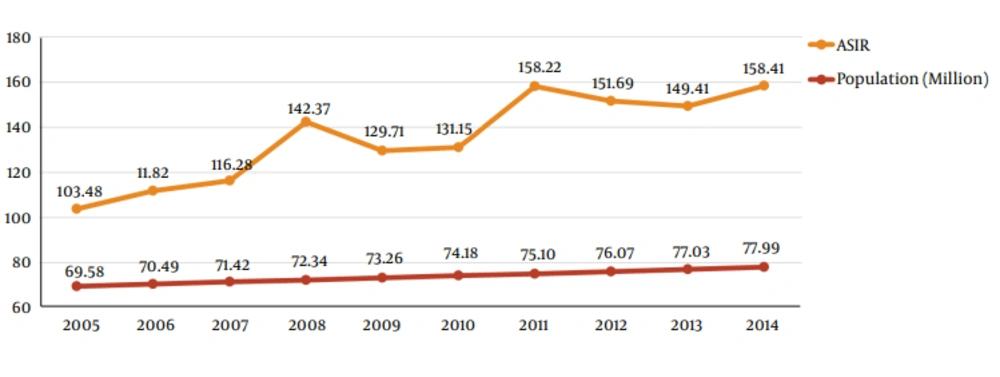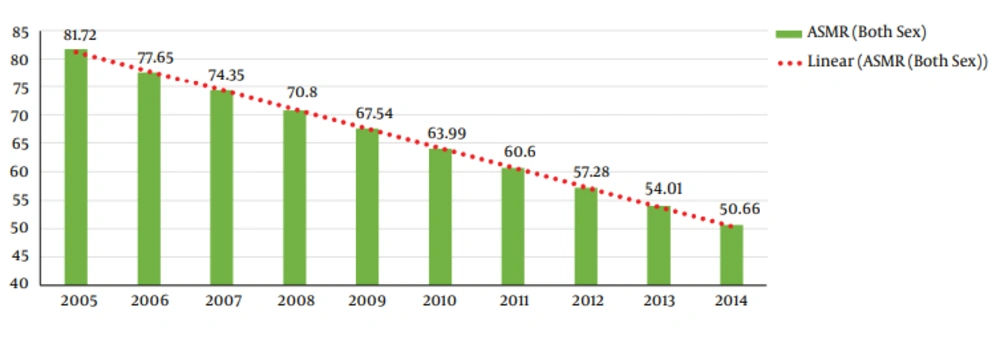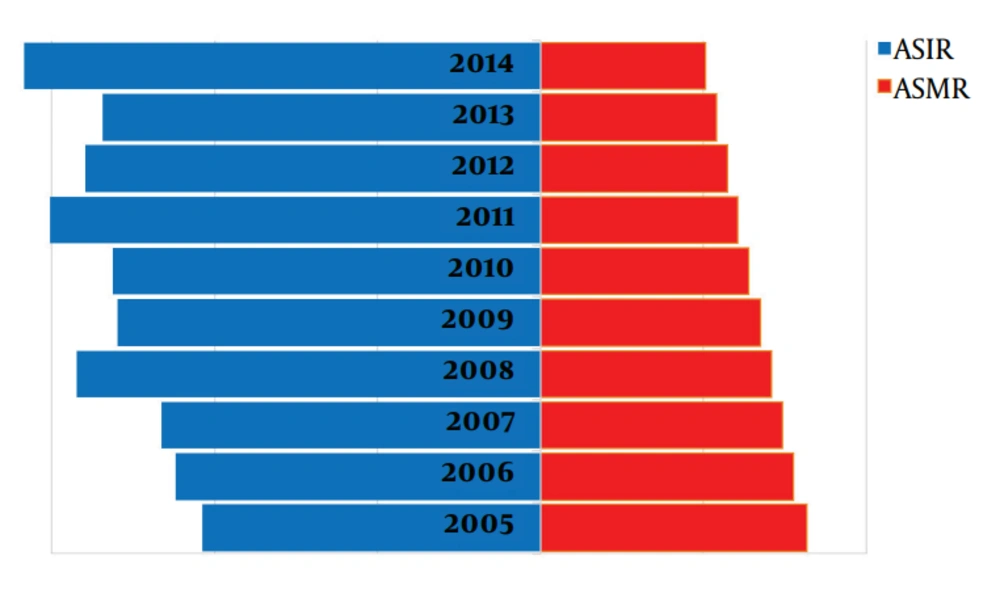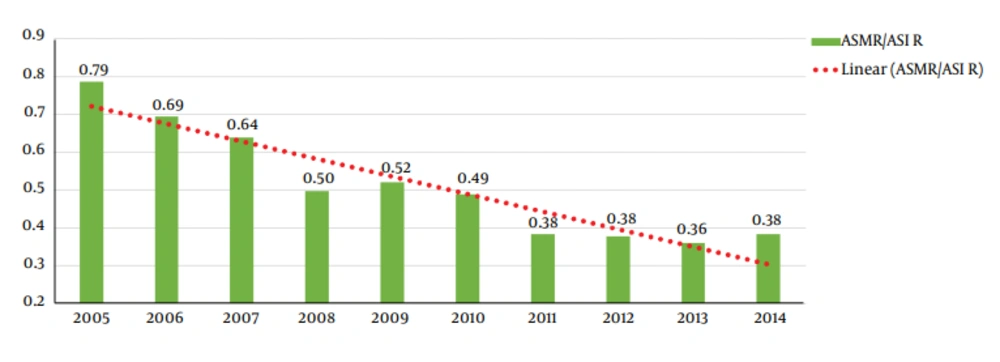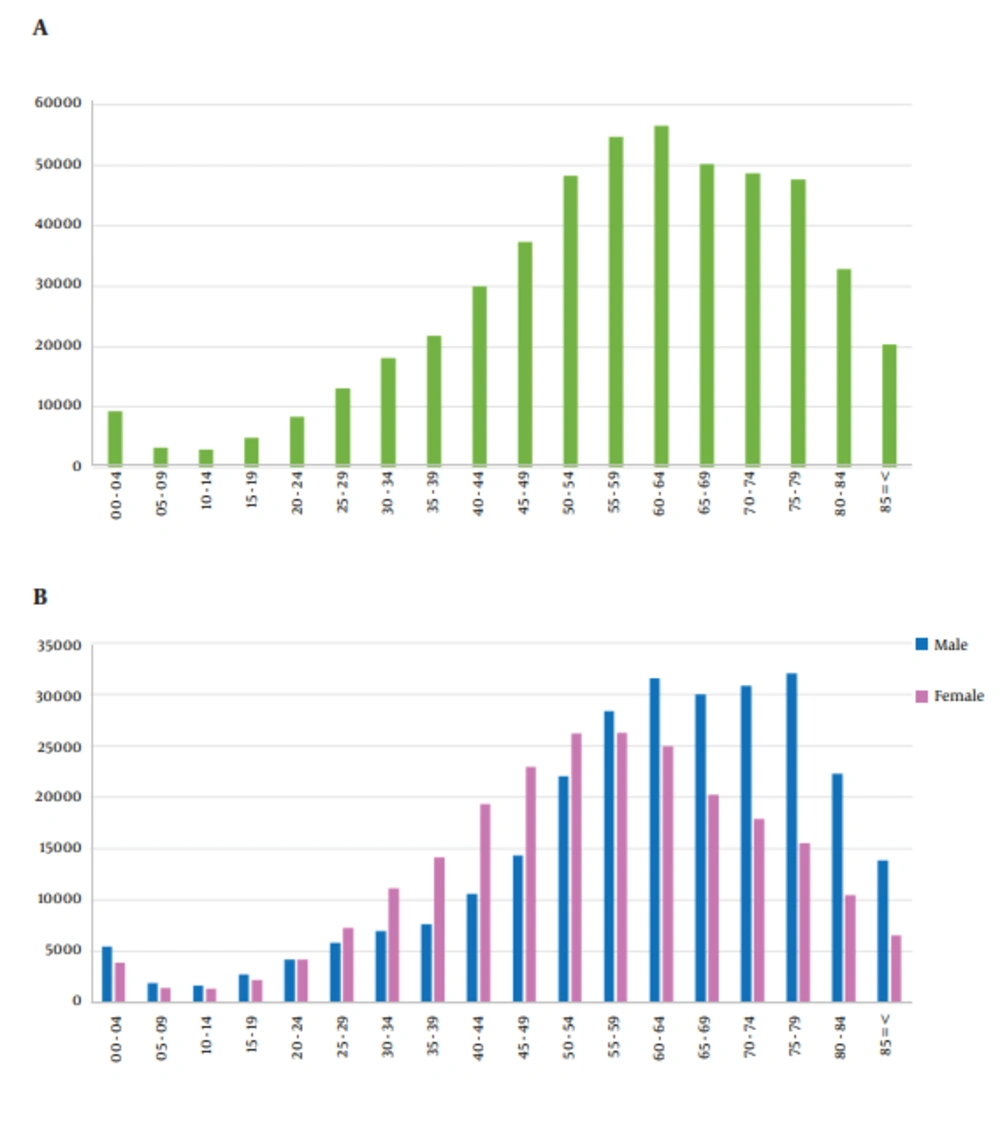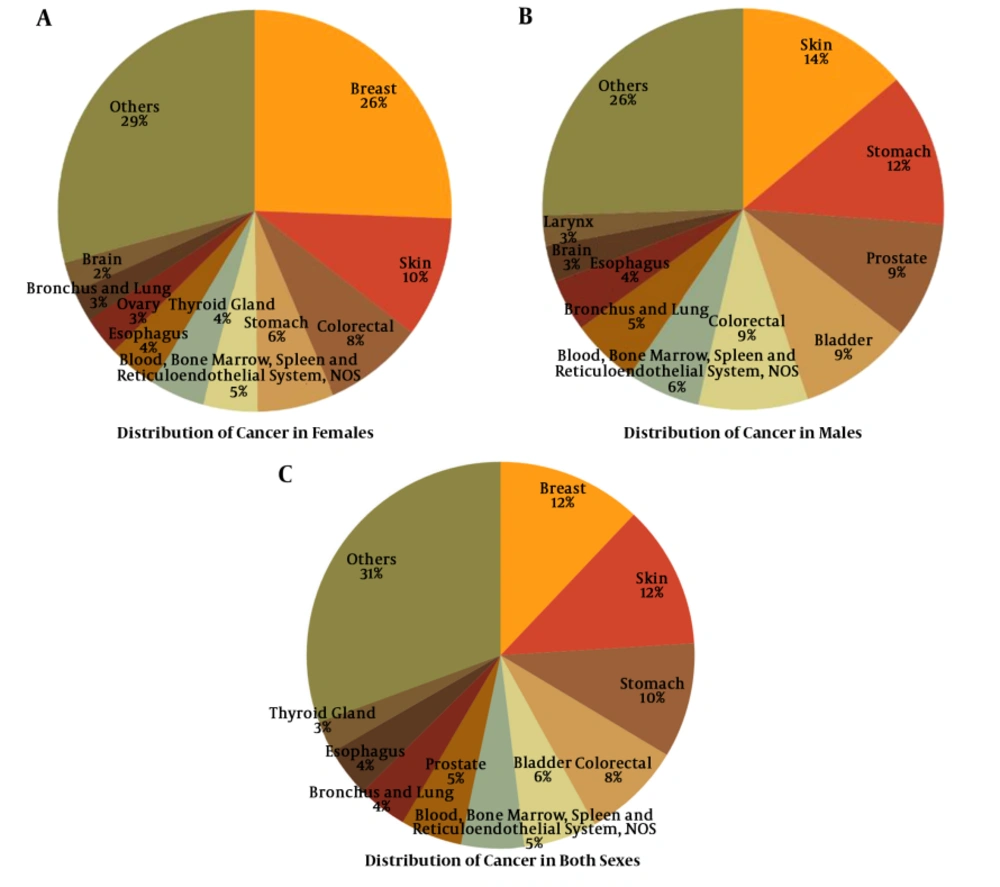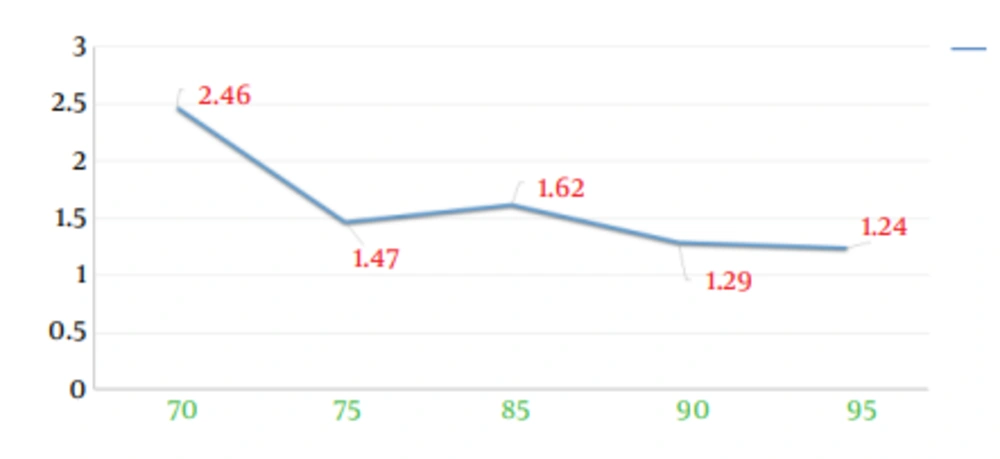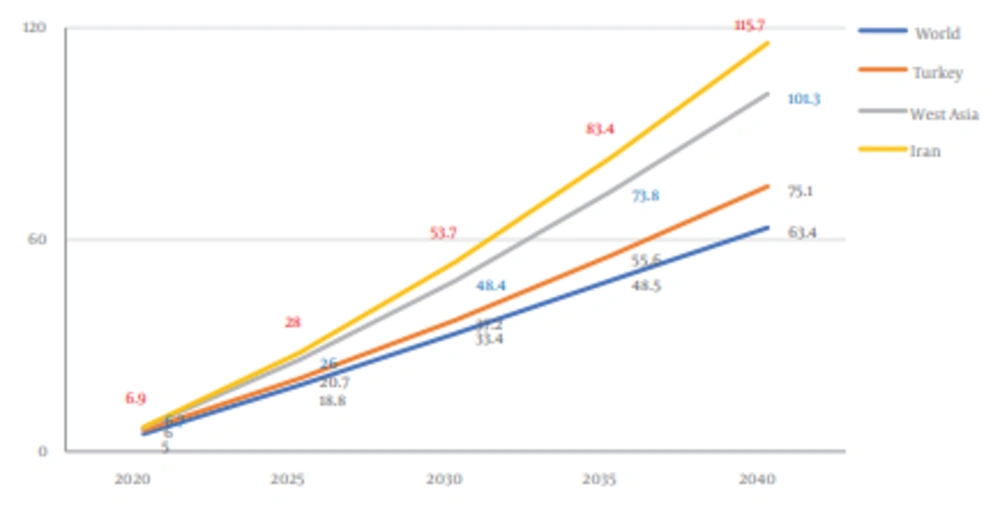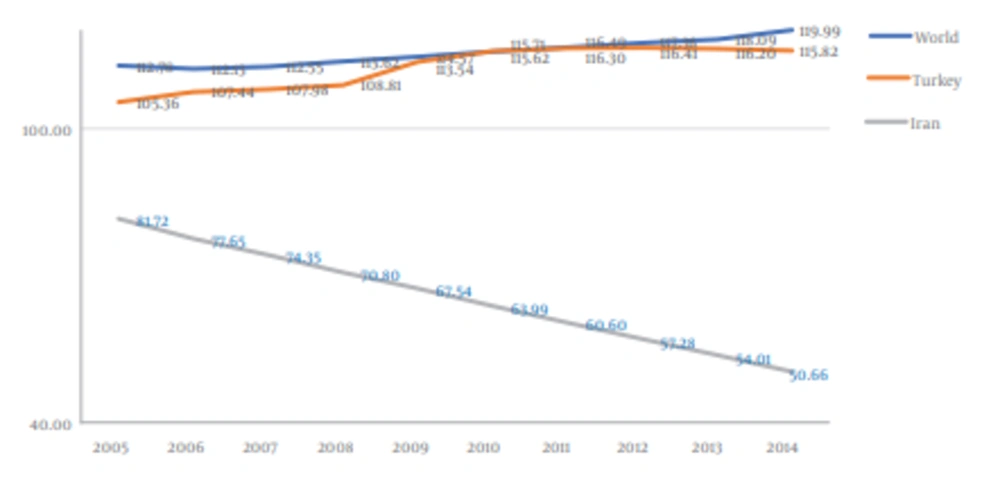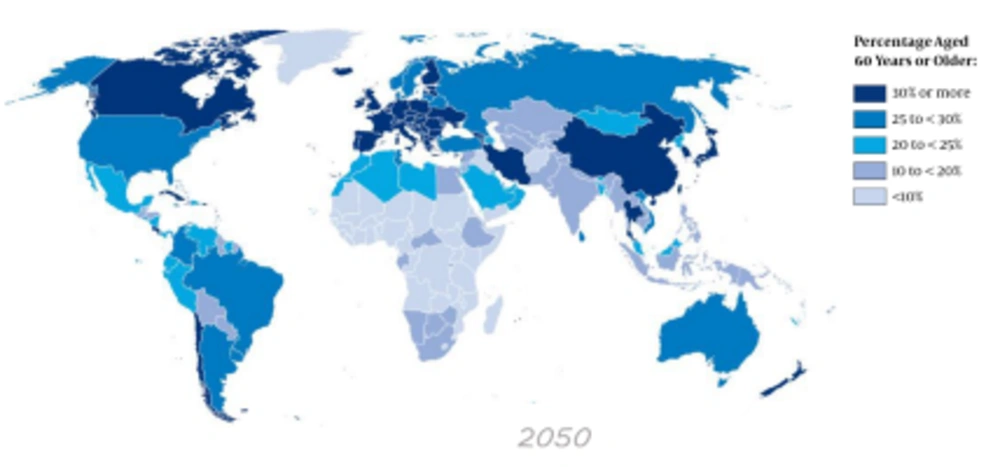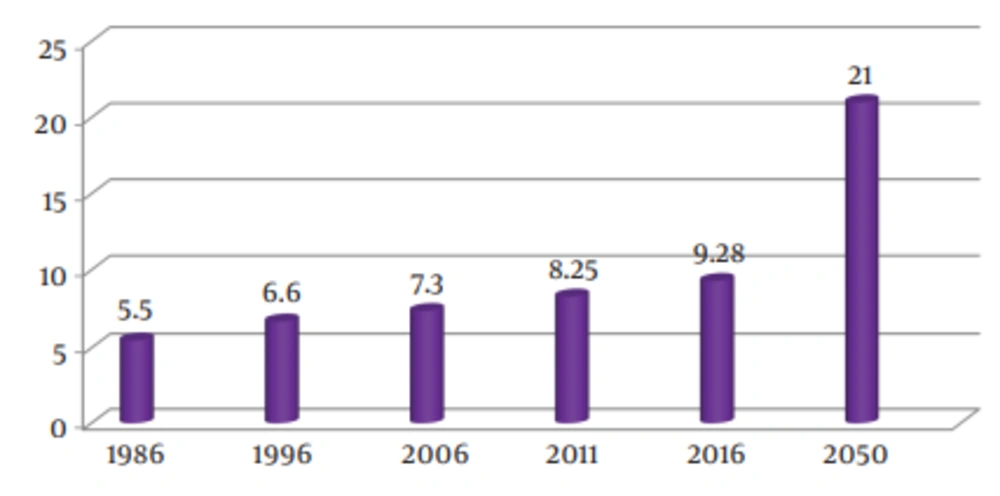1. Background
Cancer is a main health problem worldwide. In 2018, 18.1 million new cases were diagnosed and 9.6 million deaths occurred due to cancer; also, 5 years’ prevalence was 43.8 million in the world (1, 2). About 50% of these new cases and deaths were reported from Asia with 60% of population (1, 3, 4). In 2015, 8.7 million people died due to cancer, which is the second cause of death followed by cardiovascular diseases (CVD) (5-7). After dividing the CVD in two groups as ischemic heart disease and stroke, cancer is the first cause of death in the world (8). Moreover, years of life lost (YLL) due to cancer in 2017 was 19.5% higher than that of 2007. It means that the cancer burden increased in these years (5), whereas age standardized death rate in 2017 decreased by 4.4% from 2007 (8). Cancer is an obstacle for increasing life spam in the 21st century. Improvement in sciences such as immunotherapy and personalized medicine can increase hope for more survival (5).
According to the report of world health organization (WHO), the number of cancer-related deaths was 6 million in 2000, 7.6 million in 2005, and 7.9 million 2007, and this reveals 32% growth in the number of deaths during 2000 to 2007 (9). In 2007, 13% of the deaths were assigned to cancer and 72% occurred in developing countries (10-14). In 2012, about 14 million new cases and 8.2 million cancer-related deaths were registered, 57% of which occurred in developing countries. Considering this growth in incidence rate, there will be 13 million cancer-related deaths in 2030, 9 million of which will occur in developing countries (15). Increasing in the cancer burden mainly depends on the growth of population and aging (increasing in life expectancy) (3, 4, 13-21) also, risk factors and harmful life style (10, 13, 14, 20). Changing in fertility rate (4, 20) and life expectancy are two main factors affecting population pyramid (22), which can cause problems in countries with different levels of financial supports and funds. Social and financial enhancements are factors affecting the cancer burden. Nowadays, changing the view toward cancer is obviously considerable and infection-related cancers such as stomach, cervix, and liver are transited to life style-related cancers such as breast and prostate. Rapid changing in economic level is a main reason for this change (2, 23).
Researches revealed that the incidence rate of most cancers is twice to 3 times higher with high or very high human development index (HDI- which is related to life expectancy, education and income) than that of moderate or low HDI. Moreover, the difference in mortality rate is low because there is a higher rate of cancer with low survival rate in the countries with low HDI; also, early diagnosis, on time, and useful treatment is less available (11, 24).
In addition to socioeconomic factors, one of the most important and obvious factors in developing countries is the shape of population pyramid. As population increased, the reversal of the population pyramid and growth in people older than 60 years cause problems (25).
Iran is a country in the west of Asia with about 82 million populations. The population pyramid changes in its shape and people are going to be elder. New cases and number of deaths are very sensitive to the number of population and age pyramid structure (20). Regarding the increasing trend in elderly population in future, policymakers need to plan programs for cancer control, prevention, diagnosis, and treatment (7, 11, 26-29). In countries without interventional cancer control program, the cancer burden will increase by 70% (25). Cancer considers a risk factor for social economic development of the countries (25). Regarding the limitations in sources, prioritization is the main responsibility of decision makers in health system. Policymakers need tools to estimate the burden of disease in community. One of the most important management tools is epidemiological indices such as incidence or mortality rate and one of the main indices is standardized rate, which expresses the deaths or new events probability due to cancers (27). Changes in estimated indices during the time indicate the present and pervious conditions of diseases and quality of care.
Mortality incidence ratio (MIR) is an index for evaluating the cancer burden and patient’s care. In previous studies, it was introduced as a simple and effective index for cancer control programs. It reveals the quality of health system and its relationship with cancer outcomes and represents the difference between the results of cancer management in countries (11, 22, 30, 31).
2. Objectives
The aim of this study was to estimate epidemiologic indices in 10 years in Iran and indicators, which affect public health for representing the figure of cancers and their changes during times and also to analyze these variations for evaluating effect of public health system on health of population.
3. Methods
In this study, we used the data of cancer registry system for estimating national indices. The data showed the information of new cases that were diagnosed each year based on pathology reports during 2005 to 2014. From 2010 to 2013, the reports of 4 provinces used population-based registry data (not pathology reports only) and in 2014, data were retrieved for all population-based forms. In population-based registry, underestimation is less than pathology-based data. One of the problems in data retrieving of registry system is data duplication in patients, who have to carry out several biopsies for diagnostic and management procedures and register separately. Extraction of duplicate data was performed by Ministry of Health and Medical Education (MOHME) for each year except for 2011, 2012, and 2013. In order to analyze the data in the first step, duplicate data in the mentioned years needed to be omitted. For omitting duplicate data, they were adjusted based on name, family name, father name, and ICD-O code. In different years, the different amount of data were omitted. In addition, the data were completed by adjusting the sex by cancer type and name of patients. Now, we have the 10 years’ data in the best status, which are analyzed in this study. For estimating indices such as incidence and mortality rates, we need population in each year and for standardizing these indices, we need population in 5 years’ age groups. We used the website of Statistical Center of Iran for data population. In the website, data population for 2006, 2011, and 2016 were registered (32). In order to estimate the number of population in each year, we used the following formula: Population in the base year plus growth percent rate in each year.
Also, we calculated the number of population for 5 years’ age groups in this manner. To analyze the data, the frequency of new cases, incidence rate, age-specific incidence, rate, and age-standardized incidence rate were calculated. To calculate the ASIR, world standard population in 18 age groups were used (33). All of these rates were reported in 100 000 population. After calculating standardized indices for each year, we provided the plot for the trend of these indices in the 10 years.
We extracted the data for death from the visit-report website by the similar method (34). We calculated the number of deaths each year, mortality rate and age-specific as well as standardized mortality rate, and provided the plot, showing the trend of the mortality changes during this time.
The main indicator in this research was mortality/incidence ratio or MIR. It is the result of a fraction with age standardized mortality rate (ASMR) in numerator and age standardized incidence rate (ASIR) in denominator.
For calculating the ranking of cancer in this period, we merged the 10 years’ data of all cancers and ranked them based on total number of new cases for 10 common cancers. Also, we separately estimated age distribution of total cases in 10 years’ for total patients and both sexes.
4. Results
In this study, data obtained from national cancer registry system from 2005 to 2014 (10 years) were used. As mentioned before, data included 2011 - 2013 cleaned by researches and almost 9% - 10% of duplicate data were extracted each year (Table 1).
| Year | Before Duplicate Extraction | After Duplicate Extraction | Percentage |
|---|---|---|---|
| 2011 | 115,095 | 104,856 | 8.88 |
| 2012 | 115,863 | 104,296 | 9.98 |
| 2013 | 118,066 | 106,468 | 9.82 |
Percentage of Data Extraction
During 10 years, 836 436 new cancer cases were registered, which contained 455467 males and 380960 females. The male/female ratio was 1.19. There were 54.4% for males and 45.6% for females.
In this period of time, growing trend in ASIR for both sexes in all of the cancers were seen, and increasing trend was higher in incident cases than population growth (Figure 1).
ASIR was 158.41/105 and 158.22/105 as the highest item in 2014 and 2011, respectively (Figure 1). This growing trend in ASIR was also seen based on sex. In these years, growing rate in ASIR was higher in male than female. The highest ASIR in males was 177.44/105 in 2014 and 143.09/105 for females in 2011. Also, decreasing trend in ASMR was seen based on sex. In this period of time, ASMR was higher in male diagram than female (Figure 2).
ASMR decreased from 2005 to 2014, being 81.72/105 in 2005 and 50.6/105 in 2014 (Figure 3).
Figure 4 displays dual bar of incidence and mortality in different years in this period of time. Decreasing trend of death was seen from 2005 to 2014 and it was decreased by half in the last years and MIR was higher in male than female (Figures 4 and 5).
Figure 6A shows the age distribution of total count of cancer diagnosed in 2005 - 2014 with more frequency in age group 50 to 75 years old. Age groups of 60 to 64 years and 55 to 59 years contain the highest number of cancers. Frequency in age group of 60 to 80 in males and 50 to 65 in females was the highest.
Age distribution in male and female were different in all age groups and in younger ages in particular, the frequency was higher in females in 25 - 55 years and the rest are higher in males (Figure 6B).
Figure 7 shows the ranking of cancers in male, female and both sexes based on total number of new cases. Breast cancer is the most frequent cases in both sexes and also in females. Gastric cancer (after skin cancer) was the second in male, 4th in female, and 3rd in both sexes. Breast cancer contains 26% of female cancers and 12% of both sexes; in males skin cancer contains 14% of cancers, stomach cancer contains 12%, and prostate cancer contains 9%; bladder and colorectal cancers with 9% were the most common cancers.
5. Discussion
Global cancer burden is transited and its pattern is changed throughout the world with different features in different geographical mappings.
The burden is rising up and the feature of cancers is transited from infection-related cancers such as cervical and stomach cancers to life style-related cancers such as prostate and breast cancers.
The risk factors are also changing; for example, smoking is declined in developed countries and rising up in developing countries (35).
Here, we analyzed the data of national cancer registry from 2005 to 2014. Comparing to increasing the population rate, cancer cases are increasing rapidly (Figure 1). As shown in Figure 2 ASIR for both sexes is higher in male than female.
In Figures 7 and 8, the distribution of total number of cancers during 10 years of study is higher for female population with 25 to 55 years and for males with 55 years and more.
Breast cancer is the first cancer ranked in both sexes and also in females, although skin cancer, followed by stomach cancer, are two more incident cases in males in Iran (Figure 7).
Increasing rate of cancer during the period of the study, are more related to age of people. Distribution of cancer in age 25 - 55 years is higher in females because of breast cancer and over 55 years in males because of gastrointestinal cancers (Figure 7B).
Mortality due to cancer is rapidly decreased in both sexes (Figure 2); in 2014, it is 61.85/105 in males and 39.55/105 in females compared to 96.77/105 and 65.75/105 in 2005, respectively.
Reason for differences of registration of cases in different years is transition of some cancers like stomach which is coming dawn in Tehran province from first to 3rd position and the second reason is unfavorable work on data registry in some provinces and more in some others.
The ischemic heart disease and stroke are separated and do not include CVDs. Because of the transition of cancer burden, in more than 40 developed countries, cancer-related deaths at age under 70 is equal or above CVDs (36).
Assessment of cancer-specific mortality rate is an acceptable tool to evaluate secondary and tertiary prevention services (37); that is to be able to determine the early detection and quality of care.
Cancer is more complicated compared with other NCDs, because of its natural biological status and heterogeneities, but at least its trend and indicators such as MIR will be represented as the management of cancer in each country.
Total fertility rate (TFR) is declined by 49.4% in the world from 1950 to 2017 (38), and it has been 4.7 live births in 1950 and 2.4 live births in 2017.
In Iran, TFR is also declined through the last 40 years from 4.2 to 1.8 and because of that, the population growth rate is declined from 2.46 in 1991 to 1.24 in 2016 (Figure 8) (32).
During the last 30 years, the population younger than 14 years is declined from 45.5% to 24% and the population older than 65 years old is rising up from 5.5 in 1987 to 9.28 in 2017, and it is estimated to be 21% in 2051.
Although TFR is declined, the population is increased each year with the average of 83.8 million from 1985 to 2017 in the world (38).
In Iran, the population is also increased from 40835000 in 1981 to 82377228 in 2019 (32). In 2017, a little bit less than 10 million (955 6200 people) died due to cancer globally, which is 25.4% more than 2007. Age standardized death rate per 100 000 in 2017 was 121.2, which is declined by 4.4% compared to 2007and became 116.8 (15).
Also, the YLL of neoplasms increased by 19.6% from 2007 to 2017 and reaches to 225738100 years, but age standardized YLL rate is declined by 5.6% compared to 2007 and reaches to 280 314 per 100 000 people.
Regarding increase in age standardized incidence rate of cancer cases, and decrease in the age standardized death rate, this feature is related to cancer in the world and it is similar to the features that you can see in Iran (Figure 4).
Management of cancer in Iran is acceptable compared to the developed countries; so, it is good to mention some successful cancer management strategies in Iran:
a. Public awareness about requesting medical care.
b. Increasing accessibility and availability of medical care facility including man power.
c. Progressing team work for early diagnosis and better management through the country.
As Globocan estimated, the growth rate of cancer at next 20 years from 2020 to 2040 is noteworthy; this growth rate is 63.4% for world, 75.1% for Turkey (as a simple in the region), and 101.3% for west Asia, but it is 115.7% for Iran, which means the cancer cases in Iran will become at least twice more during next 20 years (Figure 9) (2).
The estimation of population in Iran and Turkey at that time would be similar and both countries have around 93 to 95 million people, but incidence rate is dramatically higher in Iran (115.7% vs. 75.1%). Despite the growing of incidence rate during the study period, the mortality rate in Turkey and world is almost steady or little rising, but in Iran, it is decreasing rapidly (Figure 10).
As it is reported by statistical center of Iran and also estimated by WHO (Figure 11), the rate of population older than 60 years in Iran is less than 10% (9.28% - 9.8%), but during 2020, it is ≤ 20% and in the next 10 years, it would be ≤ 30% and after the next 20 years (during 2050), it will be 30% or more, but for Turkey, it is more stable and remained less than 10% until 2050 (2).
The TFR and life expectancy are more important issues; population is getting older and it is the most powerful reason for increasing cancer cases in Iran (Figure 12) (38).
Also in the Figure 1, the trend of population and cancer incidence during 10 years of study are not compatible and the incidence rate of cancer changed from 75 to 141 per 100000.
The trend of ASMR to ASIR, which is called MIR, is very interesting during 10 years of study from 2005 to 2014 (Figure 5).
It is changed from 0.79% to 0.32%, meaning that nowadays more than 70% of cancer cases will survive each year, and it is a good tool for the assessment of secondary and tertiary prevention of cancer in Iran (39).
5.1. Conclusions
The population of Iran is steadily increasing, which is in line with the increase worldwide, but the rate of aged people is increasing rapidly and because of this, the incidence rate of cancer is rising up; however, the mortality rate is going down with increasing cancer burden.
The assessment of cancer management in Iran is acceptable compared to the developed countries.

